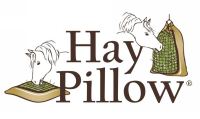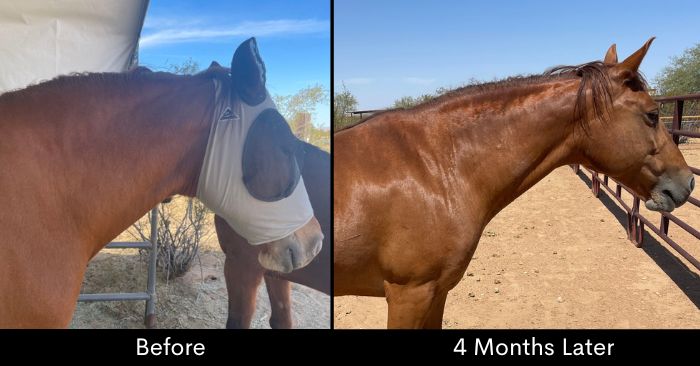Healthy Gradual Weight Loss for Horses vs. Fasting & Forage Restriction
Have you tried to help your horse lose weight and, despite your best efforts, succeeded only in frustrating you both?
I routinely get calls from equine guardians who, despite implementing a “diet” and slow feeders, report that their horses are bored and miserable, standing around with nothing to eat – or eating dirt, manure, shavings – even destroying objects. These folks tried to do everything “right,” yet they did not achieve positive results.
Why? Because their weight loss strategy did not take several important factors into account. Read on to learn why you should say no to crash diets, what a healthy gradual weight loss protocol is, why it's crucial to keep periods of fasting to a minimum - and to see what helped the horse pictured above reduce her weight and insulin resistance in four months.
Say No to Crash Diets
Here is a far too common scenario I hear: An equine guardian is instructed by a trusted source to put their horse on a “diet” by limiting their forage intake to 1% of their current body weight with no regard to extended periods of fasting, the type of forage being fed or whether nutritional needs are being met. The reported result: Loss of muscle, fat deposits remain the same or worsen, the horse is miserable, and they feel guilty and at a loss.
While it may seem counter intuitive, drastically reducing calories (an equine crash diet) can quickly backfire - resulting in a sluggish metabolism, insulin spikes, muscle loss and storage of fat to compensate.
Equines require a minimum number of healthy calories and nutrient levels (water, fats, carbohydrates, protein, vitamins and minerals) to maintain as much muscle as possible and lose weight/fat while striving to achieve optimum thyroid/hormone function. No equine is immune to being malnourished, including overweight individuals.

3 Rules of Healthy Gradual Weight Loss
1) Feed A Healthy Balanced Diet & Provide Adequate Nutrients
The recommended core diet for weight loss should include:
Forage: Tested low sugar/starch (10% or less in NSCs) grass hay with lots of fiber and adequate nutrients. If you can’t test your hay, the best choice is to feed mature grass hay because it has the lowest propensity for storing sugar and starch (2nd to environmental conditions), is less palatable and requires more chew time. Testing your hay is always optimum.
- Ration balancer: If you can’t test your hay, provide a concentrated comprehensive vitamin/mineral ration balancer for optimum thyroid/hormone function. If you do test your hay, consult an equine nutritionist to formulate a custom ration balancer according to your forage analysis to compensate for vitamin/mineral deficiencies and achieve optimum ratios.
- Salt: Feed the minimum requirements in daily supplements and provide access to free choice loose salt or a white salt block.
- Omegas: Feed ground flaxseed at a rate of 4 ounces per 1,000 pounds of body weight. One ounce of ground flaxseed is approximately 1/4 cup or 4 Tablespoons.

The ration balancer, salt and ground flaxseed should be split into 2 feedings (morning and night) with a carrier such as soaked hay pellets - not grain or complete feeds.
2) Ensure Your Horse Is Getting Enough Forage
The absolute minimum amount of grass hay (less than 10% NSC's) to feed for weight loss is 1.5% of your horse's current body weight or 2% of ideal weight, whichever is more.
Note: Flakes of hay are not appropriate to use as a measurement. A flake of hay can vary drastically in dimensions (size of bale), thickness and density.
If you are feeding meals, these two steps will help to keep periods of fasting to a minimum (more about the importance of this topic to follow):
Weigh rations to ensure the minimum amounts of forage are being provided and allocated. To weigh your hay, use a digital fish scale and large bag (IKEA bags work great).
Allocate the amount of hay over a 24-hour period. For example, if you feed 24 pounds of hay a day (24 hours) = 1 pound per hour. Say you feed breakfast at 8:00 AM, lunch at 1:00 PM and dinner at 6:00 PM. Breakfast should be 5 pounds, lunch 5 pounds and dinner 14 pounds.

Why is it important to keep periods of fasting to a minimum?
Because fasting for more than a few hours worsens Insulin Resistance/Dysregulation in horses.
According to the equine study The Effect of Fasting Duration on Baseline Blood Glucose Concentration, Blood Insulin Concentration, Glucose/Insulin Ratio, Oral Sugar Test, and Insulin Response Test Results (https://www.ncbi.nlm.nih.gov/pmc/articles/PMC5032872/):
“Starvation and very low-calorie diets have been shown to cause insulin resistance and diabetes in rodents and humans.
These data suggest that withholding feed for more than a few hours will decrease insulin sensitivity, and may be counterproductive to the treatment goals in EMS [Equine Metabolic Syndrome]
In summary, the longer a horse was fasted, the more likely it was to be classified as insulin‐resistant when performing the IRT (insulin response test).”
Insulin Resistance/Dysregulation Defined – How Fasting Induces/Worsens IR
Dr. Juliet Getty graciously expanded on the topic:
“Insulin Resistance/Dysregulation is when an individual experiences significant increases in insulin levels in the bloodstream because they are unable to “open the cells gates” to deliver glucose to the body’s cells to burn as fuel. In other words, the cells become "resistant" to insulin, or less sensitive, resulting in higher levels of glucose in the blood. The pancreas senses this elevated level of glucose (hyperglycemia) and responds by secreting even more insulin. This impaired insulin metabolism is referred to as insulin dysregulation.
A healthy horse will have cells that are sensitive to insulin. It has been shown that allowing horses to be fed on a regular basis will improve insulin sensitivity. Conversely, withholding feed and/or forage for more than a few hours, will induce insulin resistance, leading to elevated blood insulin levels (hyperinsulinemia). As insulin rises, it tells the fat cells in the body to hold onto the fat. Therefore, restricting forage, for example, can have the opposite intended effect; it can cause the horse to lose muscle and become more obese.”

Insulin sensitivity fluctuates throughout the day and night depending on numerous factors, including fasting. An equine with extended periods of fasting and/or underfed and/or malnourished can:
- Exhibit food anxiety and/or aggression
- Lack energy
- Display a defeated, anxious or withdrawn demeanor
- Experience muscle loss with little or no reduction in fat deposits
- Chew on inanimate objects
- Eat shavings, dirt, poop or whatever they can find to chew and swallow
3) Avoid Periods of Fasting Without Weight Gain + Add Bulk & Chew Time
This concept is what confounds so many that follow the above feeding protocol, yet weight loss isn’t happening. Most have implemented slow feeders, but find it impossible to avoid prolonged periods of fasting. In addition, they are either feeding untested hay or tested low sugar/starch hay – and unaware that the hay is 1) highly palatable and 2) higher in digestible energy and lower in fiber than it should be to confidently feed more than 1.5%-2% of their body weight a day.
What to do? Avoid periods of fasting by feeding a low NSC forage that is higher in fiber and lower in digestible energy. Offer this as a slow fed free choice forage option. This could be in the form of a very mature grass hay or straw to:
- Improve insulin sensitivity
- Elevate and regulate metabolism
- Achieve satiation
- Decrease digestible energy per pound
Reduce palatability
- Encourage self-regulation (the ability to stop eating when forage is present)
- Maintain a well-balanced population of microbes in the digestive tract.
To achieve adequate protein in the diet, you may need to supplement mature grass hay or straw with limited amounts of an immature cutting of grass hay, alfalfa, or a protein rich concentrated supplement.
Straw tends to be a controversial form of forage to many, but is commonly fed in conjunction with limited amounts of grass hay to manage weight in other parts of the world. Here’s some additional reading about straw, based on scientific evidence:
2 Important Tips
- Gradually introduce new forages. Begin by blending small amounts of less palatable forage with your current hay, increasing the percentage over time. Blending palatable and less palatable varieties typically results in the same enthusiasm and rate of consumption. When your herd has adapted to the new forage, feed them separately to achieve optimum results.
- Routine dental exams are a necessity for all of our beloved companions, regardless of what they eat. Higher NDF/ mature forage requires optimum mastication (grinding), which requires unobstructed motion of the jaw. Any condition causing pain can discourage the required chew time necessary for proper digestion.
Is it Possible to Achieve Weight Loss & Provide Slow Fed, Free Choice Forage?
Yes! Reba's story is a great example:
Reba was surrendered to Desert Sky Ranch & Sanctuary suffering with laminitis and diagnosed with Insulin Dysregulation. Before her arrival, she lived alone in a stall with a small dry lot turn out and was fed meals consisting of Bermuda grass hay, Alfalfa and supplemented with a commercial feed.
Reba experienced remarkable improvements just 4 months after arriving at the rescue, who provided her with a healthy, gradual weight loss protocol that consisted of:
- A large paddock with a small wooded track along with a companion
- Slow fed free choice Bermuda grass hay
- Ration balancer in a ground flaxseed base, salt and herbs mixed with soaked hay pellets
Reba’s results speak for themselves.

Photo on left, when Reba arrived at the sanctuary. Photo on the right, 4 months later.
In Closing
Testing your hay or straw is optimum to ensure nutrients and digestible energy requirements are being met, fed in conjunction with a ration balancer, salt and ground flaxseed.
Healthy weight loss takes time, be patient. Prolonged periods of fasting and starvation/crash diets are not the solution. They compromise your companion’s mental and physical health and well-being.
You can also read about my slow fed free choice journey: Are You a Prisoner of Feeding? Here's How I Broke Free.
Special thanks to:
- Dr. Getty for taking the time to contribute to this article and answering my questions throughout the years.
- Desert Sky Ranch & Sanctuary for your selfless efforts to rescue and rehabilitate Reba and all the other residents with kindness, knowledge and compassion.
Helpful Resources
- Slow Feeding - Tips & Techniques
- 9 Benefits of Slow Feeding Horses - Get Slow Feed Savvy
- Horse Slow Feeder Safety Tips
- Can Horses Eat More Hay Without Weight Gain? The Surprising Factors
- 7 Slow Feed Do’s and Don’ts for Horses
- Slow Feed Solutions by Enclosure Type & Weather Condition
- Choosing a Mesh Size
- How I Chose the Best Slow Feeder for My Horse
- Study - How Hay Feeder Height Affects Jaw, Neck & Back Posture in Horses
References
- Crandell, K. (2015, May 5) Fighting Equine Obesity: No Crash Diets for Horses Retrieved from https://ker.com/equinews/fighting-equine-obesity-no-crash-diets-horses/
- Bertin, F., Taylor, S., Bianco, A., Sojka‐Kritchevsky, J. (2016, Aug 2) The Effect of Fasting Duration on Baseline Blood Glucose Concentration, Blood Insulin Concentration, Glucose/Insulin Ratio, Oral Sugar Test, and Insulin Response Test Results in Horses Retrieved from https://www.ncbi.nlm.nih.gov/pmc/articles/PMC5032872/
- Getty, J. (2017, August 2) Forage Deprivation Keeps Horses Fat. Retrieved from https://www.americanfarriers.com/articles/9339-forage-deprivation-keeps-horses-fat
- Kellon, E. Nutritional Needs for Equine Metabolic Syndrome (EMS) and PPID/Cushing's Horses. Retrieved from https://www.ecirhorse.org/DDT+E-diet.php
- Williams, C. (2004, April) The Basics of Equine Nutrition. Retrieved from https://esc.rutgers.edu/fact_sheet/the-basics-of-equine-nutrition/
- Kellon, E. (2021, May 24) Flax To Mimic Pasture. Retrieved from https://drkhorsesense.wordpress.com/2021/05/24/flax-to-mimic-pasture/
- XL Equine Equine Obesity - Prevent and manage this serious welfare problem Retrieved from https://www.horseanswerstoday.com/veterinary/a-to-z-of-horse-ailments/item/1861-equine-obesity-prevent-and-manage-this-serious-welfare-problem
- Kellon E., Physiology of Equine Metabolic Syndrome (EMS). Retrieved from https://www.ecirhorse.org/physiology-EMS.php
- Gunnars, K. (2019, July 24) Insulin and Insulin Resistance -The Ultimate Guide Retrieved from https://www.healthline.com/nutrition/insulin-and-insulin-resistance
- Jansson, A., Harris, P., Davey, S,3 Nanna Luthersson, Ragnarsson, S., Ringmark, S.( 2021, Jul 24) Straw as an Alternative to Grass Forage in Horses—Effects on Post-Prandial Metabolic Profile, Energy Intake, Behaviour and Gastric Ulceration https://www.ncbi.nlm.nih.gov/pmc/articles/PMC8388405/



